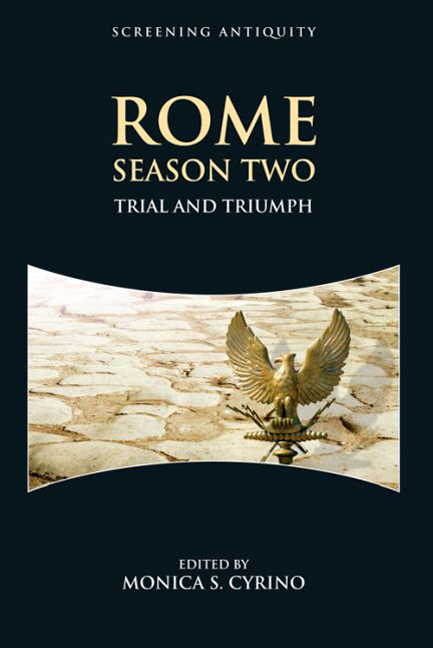Book contents
- Frontmatter
- Contents
- Series Editors’ Preface
- Editor's Acknowledgments
- Contributors
- List of Illustrations
- Episode Listing
- Cast List
- Introduction: The Trials and Triumphs of Rome, Season Two
- PART I POWER AND POLITICS
- PART II Sex and Status
- 8 Revenge and Rivalry in Rome
- 9 Effigies of Atia and Servilia: Effacing the Female Body in Rome
- 10 Livia, Sadomasochism, and the Anti-Augustan Tradition in Rome
- 11 Windows and Mirrors: Illuminating the Invisible Women of Rome
- 12 Antony and Atia: Tragic Romance in Rome
- 13 Problematic Masculinity: Antony and the Political Sphere in Rome
- 14 Rome, Shakespeare, and the Dynamics of the Cleopatra Reception
- 15 The Rattle of the Sistrum: “Othering” Cleopatra and Egypt in Rome
- 16 Gateways to Vice: Drugs and Sex in Rome
- 17 Slashing Rome: Season Two Rewritten in Online Fanfiction
- Filmography
- Bibliography
- Index
15 - The Rattle of the Sistrum: “Othering” Cleopatra and Egypt in Rome
from PART II - Sex and Status
Published online by Cambridge University Press: 07 October 2017
- Frontmatter
- Contents
- Series Editors’ Preface
- Editor's Acknowledgments
- Contributors
- List of Illustrations
- Episode Listing
- Cast List
- Introduction: The Trials and Triumphs of Rome, Season Two
- PART I POWER AND POLITICS
- PART II Sex and Status
- 8 Revenge and Rivalry in Rome
- 9 Effigies of Atia and Servilia: Effacing the Female Body in Rome
- 10 Livia, Sadomasochism, and the Anti-Augustan Tradition in Rome
- 11 Windows and Mirrors: Illuminating the Invisible Women of Rome
- 12 Antony and Atia: Tragic Romance in Rome
- 13 Problematic Masculinity: Antony and the Political Sphere in Rome
- 14 Rome, Shakespeare, and the Dynamics of the Cleopatra Reception
- 15 The Rattle of the Sistrum: “Othering” Cleopatra and Egypt in Rome
- 16 Gateways to Vice: Drugs and Sex in Rome
- 17 Slashing Rome: Season Two Rewritten in Online Fanfiction
- Filmography
- Bibliography
- Index
Summary
This chapter focuses upon the representations of Cleopatra and the city and court of Alexandria in Season Two of the HBO–BBC series Rome. This exploration considers some of the significant production decisions, which appear to have been made in an effort to increase the sense of “otherness” in the depictions of the Alexandrian court, in both set and costume design as well as in casting and performance. My discussion highlights many of the actual two- and three-dimensional artefacts from which Carlo Serafin, the supervising art director, and April Ferry, the costume designer, along with their teams, evidently drew inspiration, while drawing certain parallels with the depictions of the Ptolemies and their city in earlier film, television, and stage productions.
EGYPT AS “OTHER”
From the outset, the producers of Rome were presented with something of a problem: their depiction of the city of Rome and its inhabitants was already a considerably grimier and more alien representation than the cinema-literate audience might expect from its more sanitized depictions in Hollywood epics such as Stanley Kubrick's Spartacus (1960) or, even more recently, Ridley Scott's Gladiator (2000). How, then, should the even more exotic and decadent city of Alexandria and its Egyptian queen be depicted?
First and most importantly, the designers took a clear tonal decision to represent the palace and its inhabitants as an almost entirely Egyptian society, eschewing the more obviously Hellenistic modes of dress, architecture, and internal décor which would have existed throughout the historical Alexandria of this period. No doubt this is a common problem for those attempting to visualize the Ptolemies and their world. Cleopatra VII Philopater, to give the queen her full name, was known as the first of her lineage to read and speak the Egyptian language, indicating that Greek was the more usual tongue and script used at the Alexandrian court. Sculptural representations show the ruling dynasty in both Egyptian and Hellenistic garb, depending upon the purpose for which the statuary was intended, although it is impossible to say which of the two modes may have been the more usual in daily life. It is normally suggested that Hellenistic dress would have been the general rule, while purely Egyptian dress was reserved for formal state occasions and more religious contexts.
- Type
- Chapter
- Information
- Rome Season TwoTrial and Triumph, pp. 193 - 205Publisher: Edinburgh University PressPrint publication year: 2015



